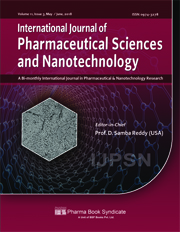Dissolution Behaviour of the Poorly Water-Soluble Drug Mefenamic Acid from Polymeric Micelles
DOI:
https://doi.org/10.37285/ijpsn.2018.11.3.3Abstract
The aim of the work was to study the dissolution behaviour of the poorlywater-soluble drug mefenamic acid (MA), a NSAID, from polymeric micelles (PMs) of Pluronic F127 and DexbLG micelles.DexbLG Copolymer was synthesised by cross-linking reaction using Dextran and PLGA. Drug excipient compatibility study was carried out by Fourier transform infrared (FTIR) spectroscopy and differential scanning calorimetry (DSC). Pluronic F 127 and DexbLG Polymeric micelles formulation were prepared by co-solvent evaporation technique. Formulations were evaluated for particle size, Zeta potential, solubility studies, drug loading and encapsulation efficiency. Scanning electron microscopy (SEM) analysis was performed to study the size and surface morphology of the PMs. SEM image showed smooth surfaced spherical micelles. The drug loading efficiency was more inpluronic F 127 micelles. Polymeric micelles showed negative Zeta potential value indicating that they are stable and resist aggregation. Solubility of MA has increased to 6 - 13 folds from PMs of pluronic F127 and 4-11folds from DexbLG micelles. Particle size was less than 100 nm and polydispersity index was less than 0.5 indicating uniform size distribution. Percentage cumulative drug release from the Pluronic micelles was higher than DexbLG micelles. It can be concluded that MA PMs formulation has significantly increased the solubility and thereby increases the dissolution of the drug.These results suggest that polymeric micelles can be used to increase the solubility of poorly water-soluble drugs.
Downloads
Metrics
Keywords:
Polymers, Micelles, Solubility, Mefenamic acid, Pluronic F127, DexbLGDownloads
Published
How to Cite
Issue
Section
References
Brahmankar DM and Sunil BJ (2005). Biopharamaceutics and Pharmacokinetics- A Treatise. 3rd ed. Vallabh Prakashan, Dehli.
Heimenz PC and Rajagopalan R (1997). Principles of colloid and surface chemistry, 3rd ed. New York.
Jeong Y, Kim DH, Chung WC, Yoo JJ, Kyung HC, Kim CH, Seung HH, and Kang DH (2011). Doxorubicin-incorporated polymeric micelles composed of dextran-b-poly(DL-lactide-co-glycolide) copolymer. Int. J. of Nanomedicine 6: 1415-1426.
Jeong YI, Choi KC, and Song CE (2006). Doxorubicin release from core-shell type nanoparticles of poly (DL-lactide-co-glycolide)-grafted dextran. Arch Pharm Res 29: 712-719.
Ketan TS, Anuradha KG, and Jignasa KS (2012). Drug Solubility: Importance and Enhancement Techniques. ISRN Pharm: 1-10.
Kwon GS and Kataoka K (1995). Block copolymer micelles as long-circulating drug vehicles. Adv. Drug Deliv. Rev 16: 295-309.
Leslie ZB (2013). The Role of BCS (Biopharmaceutics Classification System) and BDDCS (Biopharmaceutics Drug Disposition Classification System) in Drug Development. J Pharm Sci 102: 34-42.
Letchford K, Liggins R, and Burt H (2008). Solubilization of hydrophobic drugs by methoxy poly(ethylene glycol)-block-polycaprolactone diblock copolymer micelles: theo- retical and experimental data and correlations, J Pharm Sci 97: 1179-1190.
Manas B, Puja K, Gunjan S, Mrinal KB, Biplab B, and Rahaman MMM (2013). Effect of xanthan gum and guar gum on in situ gelling ophthalmic drug delivery system based on poloxamer-407. Int. J. Biol. Macromol 62: 117-123.
Marie CJ and Leroux JC (1999). Polymeric micelles-a new generation of colloidal drug carriers. Eur. J. Pharm. Biopharm 48: 101-111.
Mira FF, Mariana C, and Françoise MW (2004). Polymeric micelles for oral drug delivery: Why and how. Pure Appl. Chem 76: 1321-35.
Mourya VK, NazmaInamdar, Nawale RB, and Kulthe SS (2011). Polymeric Micelles: General Considerations and their Applications. Ind J Pharm Edu Res 45: 128-38.
Sawant RR and Torchilin VP (2010). Polymeric micelles: Polyethylene glycol-phosphatidyl- ethanolamine (PEG-PE)-based micelles as an example. Methods Mol Biol 624: 131-149.
Shaoxin F (2009). Studies on drug solubilization mechanism in simple micelle systems. Uknowledge 3-5.
Sharma R, Ahuja M, and Kaur H (2012). Thiolated pectin nanoparticles: prepa- ration, characterization and ex vivo corneal permeation study. Carbohydr Polym 87: 1606-10.
Yalkowsky, S.H (1999). “Solubility and Solubilization”. Oxford University Press, NewYork.
Zerrin S, Nilufer Y, and Tamer B (2006). Preparation and characterization of polymeric micelles for solubilization of poorly soluble anticancer. Eur. J. Pharm. Biopharm 64: 261-268.






